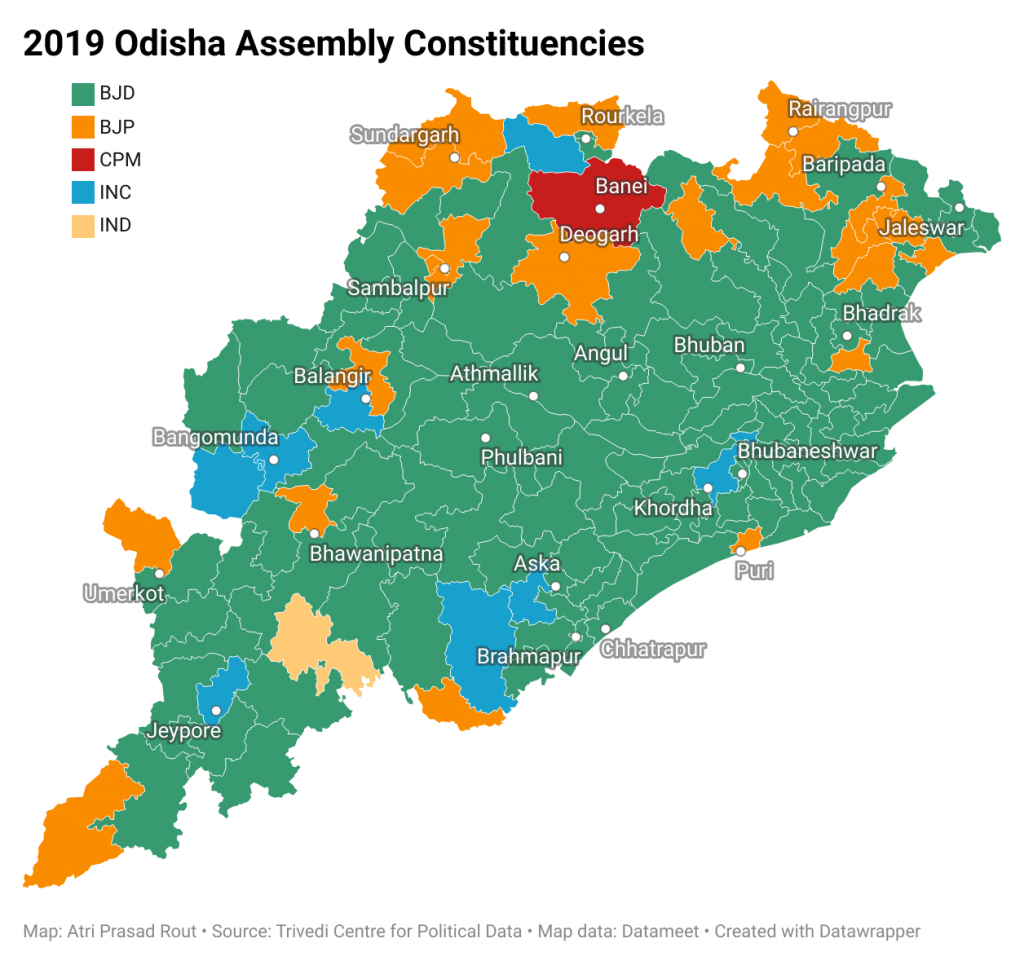In August 2023, the India Today ‘Mood of the Nation’ ranked Naveen Patnaik the most popular Chief Minister at the state level. But the ranking was not new for Patnaik as he has been at the top of such lists several times earlier, often outranking his contemporaries like Arvind Kejriwal and Yogi Adityanath in terms of popularity in the home state.
Naveen’s popularity though is not surprising given he has been the Chief Minister of Odisha for over 23 years now (23 years and 7 months 4 days to be precise), serving five consecutive terms, surpassing the record of West Bengal’s Jyoti Basu (23 years and 138 days), and second only in the country to Sikkim’s Pawan Kumar Chamling (24 years and 166 days). Biju Janata Dal (BJD), the party he leads, has been winning the majority of seats in Assembly – starting from 68 in 2000, its first assembly election as a political party, to 112 in 2019.
Making of a giant
BJD’s reign in Odisha for over two decades is phenomenal as in the decades before 2000, fortunes of political parties in the state used to fluctuate. For example, in the 1985 elections for the 9th Assembly, the incumbent Indian National Congress (INC) had won 117 seats, with Janata Party securing only 19. But in the next election in 1990, INC lost 91 per cent of its seats, holding onto only 10. The Janata Dal (JD), Janata Party’s successor, on the other hand won 123 seats, forming the government. But come next Assembly election in 1995, the equation changed as JD lost 61 per cent of its seats, winning only 47 and INC was back in majority with 80 seats.
Since 2000 though, BJD has been absolutely dominant. After two terms in power with the BJP in an alliance, the party went solo to form the government in 2009, following the Kandhamal riots in 2008 that tainted the saffron party’s reputation in the state and outside.
“The BJP and Congress are not really fighting against the BJD, they are competing among themselves. The anti-BJD vote gets divided between the two,” says veteran political observer and former professor of political science at Utkal University Surya Narayan Mishra.
Explaining the party’s dominance he says, “Naveen’s strategy is well-planned and organised from the village, ward to the Capital. He has been organising women since 2004; hasn’t given an opportunity to farmers to rally against him; has appeased labourers and the informal industry, and the urban voters are happy with their buses, hospitals and universities.”
Notably, adding to its collection of sops the BJD government has given land rights to the slum dwellers in cities through the Jaga Mission.
But as we approach the 17th Assembly elections in the state and the 18th general elections for Lok Sabha, an analysis of elections data from Ashoka University’s Trivedi Centre for Political Data (TCPD) shows that though BJD is dominant, elections in the state have gotten more competitive. This increase in competition can be seen in the variation in vote share over the last three elections.
Change in vote share of various political parties (the percentage of votes a party captures from the total valid votes) in Assembly elections reflects that though BJD gained significantly in 2004 and 2009 (27 per cent and 39 per cent respectively) it hasn’t made much progress in the last two elections (only two percentage points improvement from 43 per cent in 2014 to 45 per cent in 2019). And it seems the votes INC has lost over years have mostly gone to BJP, which has seen its vote share almost doubling – from 17 per cent in 2004 to 32 per cent in 2019.
Similarly, in general elections, though BJD had gained votes previously, its vote share fell two percentage points in 2019 as it lost 8 Lok Sabha seats. On the other hand, the BJP gained votes – from 21 per cent in 2014 to 38 per cent in 2019 – from one seat to eight.
“The votes for BJP are largely driven by Modi. But Modi cannot compete from every constituency. Unlike other states, BJP has failed to become a cadre-based party in Odisha. And within the party there is conflict,” says an observer.
But with elections becoming more competitive the space for maneuvers available for the ruling party seems to be constricting.
